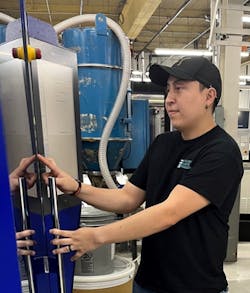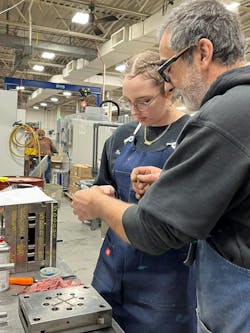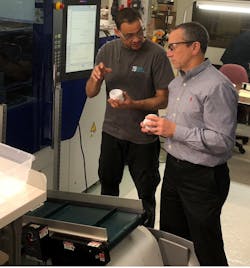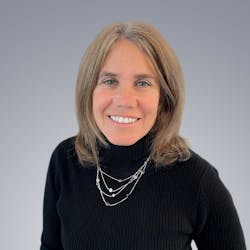By Karen Hanna
Jose Castillo had no knowledge of plastics when he began work at an injection molding plant. Fourteen years later, the 33-year-old is a shift supervisor, still working at the same company that gave him his first job as an adult.
Along the way, he said, Stelray Plastics Inc., Ansonia, Conn., has offered plenty of training opportunities, including an apprenticeship.
Over the years, Stelray has doubled down on the training it offers workers like Castillo, President Larry Saffran said. By investing in employees, he said, the company not only ensures better parts — it’s building relationships.
Like Castillo, Saffran sprinkles the word “family” into descriptions of the people who work at Stelray, which operates 24/5, producing electronics and water-filtration components, as well as parts for health-care, aerospace and automotive industries.
Work for the medical and oral-care fields has become increasingly important, Saffran said.
He said he wants Stelray to be a place where workers feel connected and comfortable, but like other employers, he acknowledged that identifying, developing and retaining new talent can be a challenge.
“Certainly, their potential is there, I think we have to foster that environment and bring them in and show them these opportunities,” he said. “I think we’ve done a good job of that. We’re not 100 percent successful, but we've definitely had success in bringing younger people into the workforce. It's exciting to have young people on board. I like the energy they bring; they have fresh ideas.”
Insight into employees
At a company with a workforce that stood at 53 in mid-September, Ann Canfield is the point person for Stelray’s training and career development.
Hired about seven years ago as the company’s accounting manager, she brings an unconventional portfolio to her job — she has a master’s degree in behavior analysis and therapy, performance management, and a passion for understanding how people learn. In addition to running the numbers for Stelray, she’s dedicated to quarterbacking the company’s professional development push.
“It's really amazing to be a part of the process where our employees are learningBased on extensive discussions with Stelray managers, Canfield has built training programs appropriate for the company’s various positions, often in collaboration with state and local agencies, along with educational institutions, like technical schools. She’s also identified funding sources, such as grants for apprenticeships.
The company uses training resources from the state of Connecticut, along with public and private industry sources.
“I think Stelray has proven that they have always given us the opportunities to grow within the company and always help alongside with the training,” Castillo said.
While managers, supervisors and co-workers provide most training to their colleagues informally on the plant floor, Stelray also increasingly makes available structured programs. Castillo, for example, has worked through classes provided by Paulson Training Programs.
Employees also can duck into a designated training room and review videos, PDF files and quizzes geared toward specific aspects of their jobs.
To track employees’ training, a few years ago Stelray began using a learning management system from Vector Solutions, which provides training for a variety of industries, including plastics.
“They were providing a lot of training manually and were having trouble delivering the training and managing the reports and records,” said Clare Epstein, the GM for the commercial sector for Vector. “And [now] they use our LMS and our ‘Good Manufacturing Practices’ courses in particular, and were able to really train their workforce much more quickly, much more effectively, and have all sorts of reports and trends.”
Canfield said she strives to cater to individual employees’ learning styles.
“We know every employee really well. The manufacturing manager, he will say, ‘This person needs this, this person needs that. This person needs a video, this person needs a class,’ ” she said. “We know our people inside and out, we interact with them.”
Managers try to anticipate workers’ needs and provide resources for them.
When employees are struggling with a concept, training presenters and the company brainstorm ways to present the information differently.
“Our training is not just checking a box and it’s done. Our training is about, ‘Did we make a difference? Did you learn something to create that awareness and clarity?’ ” said Canfield, who urges companies to think of employees as people first.
Seeing her co-workers as family shapes how she views the company’s training goals.
“The relationships and conversations we have will stand long after the part is sold and invoice paid,” she said. “We are human beings, not just human doings. We have an opportunity to build community within our workplace and invest in our people from the day they are hired. When we see the potential in staff, then staff see the potential in themselves, this influence goes beyond the shop floor into their lives, their families and change the community for the better.”
Climbing the ladder
Stelray’s training starts on Day 1, with a safety orientation, and continues through all levels of work. In his climb through the ranks, Castillo has experienced a lot of it.
“There’s this culture that’s fostered in trial and error,” Castillo said. “If you do something, you try it, if you make a mistake, it’s OK, you have another go at it, and you learn from it. And that’s one of the things that I really, really enjoy about working there and the manufacturing world in general, how you strive to continuously improve and make things better and more efficient. I think that was one of the things that really drove me.”
As a young man, Castillo admitted, his dreams had nothing to do with manufacturing; it was just a job. But a series of supervisors recognized he had potential, and they nurtured it.
He was hooked.
About six months after starting at Stelray as a 19-year-old temporary machine operator, Castillo said his supervisor promoted him to material handler, to replace a person who simply wasn’t showing up.
“The shift supervisor at the time had seen something in me that at the time I didn’t even know I had in me,” he recalled. “I started through a temporary agency, so they could have sent me anywhere. I was fortunate enough that I was sent to Stelray, where I found this group of people that push you to be better and find what it is that you like to do.”
He took part in training to improve his computer and forklift skills, eventually moving into a position created especially for him as a second-shift mold setup technician.
“Larry thought it was a great idea, having someone as young as me, driven into growing and learning the business,” Castillo said.
In moving into his current role as a supervisor, Castillo completed a 2,000-hour program created by Stelray.
Saffran congratulated Castillo in a LinkedIn post at the time: “Jose has a strong passion for the injection molding industry and his desire for learning is demonstrated through these type of personal achievements.”
Saffran has talked to Castillo about what’s next since Castillo became shift supervisor.
At Stelray, that kind of conversation about employee goals isn’t uncommon.
Younger workers appreciate the opportunity to shape their own careers, Epstein said.
“Another trend with that skills gap is that the younger generation is really interested in career development, as well,” she said. “And, so, those learning paths serve as the building blocks for their career development — and helps retain employees, as well, which is also one of the struggles we're seeing.”
That benefits everyone, as Saffran observed.
“Having a solid training program with the ability to meet staff where they are and invest in training to promote from within our organization nurtures the relationship between staff and management,” Saffran said. “We are able to see the increased confidence, care and higher-quality work from staff. Facilitating their growth and confidence increases their care and concern for our community, our customAnd Castillo isn’t the only employee who’s made significant steps up Stelray’s career ladder.
Saffran has seen materials handlers move up to mold setup technicians to shift supervisors, and from machine operators to process inspectors.
Some have moved up from machine operator to quality inspector.
Many are long-term employees.
“They’ll be given training opportunities, maybe blueprint reading or other aspects of quality training, and that could be both internal, as well as external training to get them to the next level,” Saffran said.
As a supervisor in charge of a small third-shift crew, Castillo said he now tries to emulate the mentors who have helped him advance his own career.
He’s embraced becoming both teacher and learner.
“Being in my position,” he said, “you need to recognize the people that really have an interest and the potential to grow doing the job, that they might be interested in manufacturing. So, it's my duty to do that, spend as much time as I can, explaining everything about the manufacturing world.”
Karen Hanna, senior staff reporter
Contact:
Paulson Training Programs, Chester Conn., 860-526-3099, www.paulsontraining.com
Vector Solutions, Tampa, Fla., 813-207-0012, www.vectorsolutions.com
About the Author
Karen Hanna
Senior Staff Reporter
Senior Staff Reporter Karen Hanna covers injection molding, molds and tooling, processors, workforce and other topics, and writes features including In Other Words and Problem Solved for Plastics Machinery & Manufacturing, Plastics Recycling and The Journal of Blow Molding. She has more than 15 years of experience in daily and magazine journalism.




